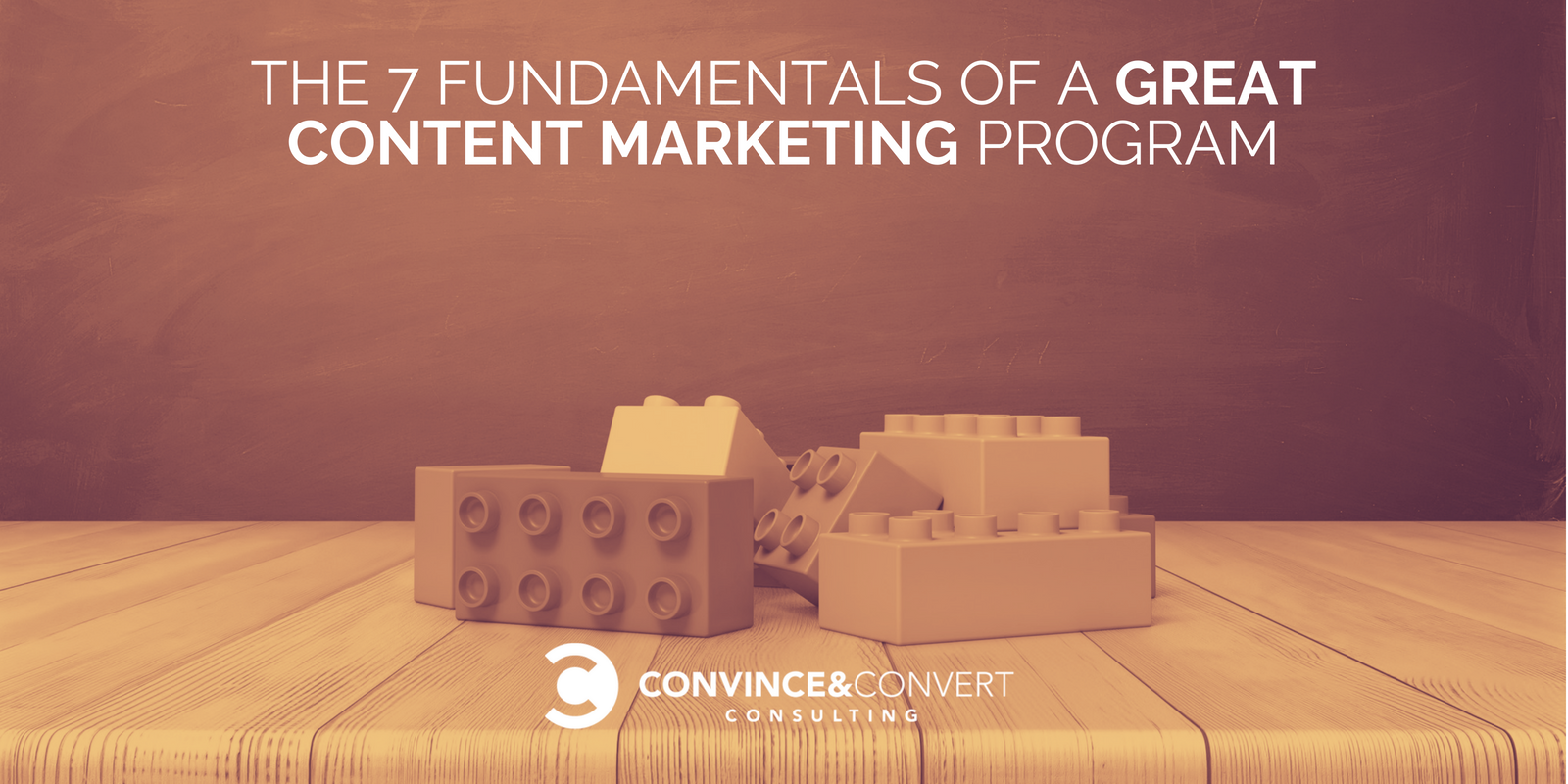
A great content marketing program can no longer be maintained with good writing alone.
Content shock has created a glut of content that is outpacing demand. Content marketers have to work harder than ever to keep an edge over the competition, or risk starving while a more savvy competitor eats their lunch.
To keep competitors at bay, or to surpass the competition, organizations sometimes forgo the fundamentals of a great content marketing program, and instead focus on new best practices and growth hacks. After all, they don’t want to wait for results. They want them now!
While the latest growth hack may sound like the future of content marketing, more often than not it’s a short-term fix to a long-term problem. Organizations latch onto a hack or a shortcut, only to find their content marketing program in disarray a few months later. It’s something we’ve seen over and over.
Here are just a few signs that a content marketing program is in trouble:
- Content marketers struggle to prove the business value of their efforts
- No one understands how new visitors move down the marketing funnel to a conversion
- The executive team is considering reallocating content marketing budgets
- User engagement on content is very poor
All of these signs lead back to a common cause: the fundamentals of the content marketing program are not in place.
Like any activity or profession, understanding the fundamentals is essential to success. If the underlying fundamentals of your content marketing program are not in place, there’s little chance of growth-hacking your way to success.
Here are the seven fundamentals that are essential to any successful content marketing program.
1. Understand Your Business Objectives
You’re not creating a content marketing program for fun. You’re creating it to accomplish a business objective.
The first fundamental of a great content marketing program is to define the business objectives you want your program to accomplish.
These objectives can include:
- Brand Health
- Marketing Optimization
- Revenue Generation
- Operational Efficiency
- Customer Experience
- Innovation
Once you’ve identified the business objectives of your content marketing efforts, you need to get buy-in from the c-suite to make it a reality.
2. Get Executive Buy-In
Your executives hold the keys to the resources your content marketing program needs. If you can’t get your executive’s buy-in and keep it over the years, your program is toast.
To get executive buy-in, focus on these six points:
- Why your organization needs content marketing—what is more appealing about it than other means of advertising/communication?
- Don’t lead with creatives when talking to executives. Your executives may like to see pretty mock-ups, but those don’t sell a program.
- Instead of creatives, lead with dollars and cents. This is the language of the c-suite.
- Tie the program to business objectives. How will the program be better than other programs at achieving specific objectives?
- Show how you will measure the strategy (this will be discussed in the fifth fundamental.)
- Lay out the budget and the expected return the c-suite should see as a result of the program. If you can’t demonstrate this, your content marketing budget will quickly get reallocated to projects that can.
3. Understand Your Audience’s Pain Points
The point of your content should be to solve your audience’s problems, not to serve as an ad for your products and services.
To understand your audience’s pain points, you need to put yourself in your audience’s shoes. What things keep them up at night? What are they worried about? What content can you provide that would make their lives easier?

Pain points come in all shapes and sizes. A pain point might be an annoyance, like gnats getting through a screen in a window. Or a pain point could be significant, like understanding how to best take care of a parent who needs additional care. Both of these examples can utilize content to give some relief to those pain points—perhaps a homemade gnat trap for the first example, and an article detailing all of the essentials someone should get in order to get their parent the best care possible.
Content intelligence utilizes massive amounts of data to identify the pain points your audience has across your site and the sites of your competitors and industry publications. This approach goes hand-in-hand with qualitative feedback such as customer focus groups, to identify the true pain points your audience has.
Another essential in determining pain points is to understand the user’s intent when they search for a solution.
If someone is searching to know the answer to something, don’t hit them over the head with calls to action to buy something. If they are looking to take an action, like get help, you should be more aggressive in getting them to take the next step with you.
If the user’s pain point is to go somewhere, like a website, or a physical location, make sure your business is easily findable online or in local search.
4. Create a Documented Content Strategy
If your content strategy is in your head, but not on paper, you may be in a lot of trouble.
Less than 40% of content marketers have a documented content strategy. As a result, only 35% of content marketers can actually demonstrate the ROI of their content marketing efforts. Share on XSelling your executives is essential to acquiring and maintaining resources for content marketing. If you can’t point to a documented content strategy, and thus prove the ROI of your content marketing efforts, your budget will be quickly reallocated.
It takes time and effort to create a great content marketing strategy. But it’s essential, as your entire content marketing program depends on it to succeed.
It also gives your entire content team a single source of truth when creating future content marketing campaigns.
5. Identify the Methods and Metrics for Measurement
To prove your content marketing program’s value, you need to identify the methods and metrics you will use before you create a single piece of content.
These metrics should tie back to the first fundamental of content marketing programs: Understand Your Business Objectives.
The metrics you use should be identified within your content marketing strategy, as well as each content marketing campaign.
Companies that delay this step until the end of their campaign end up scrambling to show the success of the campaign. Without having a clear method for measurement set up at the beginning, they are left with vanity metrics like total inbound traffic or social shares instead of solid metrics that prove the content campaign drove an actual business outcome.
This leads to some really awkward conversations with the c-suite.
6. Identify the Most Effective Distribution Channels
How does your audience get content that helps them solve their problems?
Do they rely solely on search? Then a focus on SEO is probably a place for you to start.
Is your audience mostly on social media? It might be time to create social-friendly articles that will pique their curiosity.
Do they regularly read a certain industry publication? Perhaps utilizing sponsored content on that publication is a good channel.
Do they prefer to have a physical paper? Then it might be time to look at printing and shipping a magazine (yes, they are still around).
Figure out where your audience is currently getting the solutions to their problems. A lot of the time we see organizations jump into new channels just because they are new. But they never did the research to see if their audience is in that channel.
It’s easier to get the attention of an audience in their normal channels than trying to get them to join you in a new channel.
7. Create Amazing, User-centric Content
Yep, we’re at fundamental 7 of 7, and we’re just now talking about creating content. That’s because the legwork that leads up to the content is the most important factor in the content’s success at the business level.

Writing amazing, engaging content is essential to any content marketing campaign. That content needs to be user-centric, making your audience the hero of the story.
You’re not writing creating content to talk about you. You’re creating content to solve the user’s problem.
You’re not creating content to talk about you. You’re creating content to solve the user’s problem. Share on XThis is one of the biggest mistakes we see from organizations. They think content marketing is simply a way to write long-form advertisements. Check your organization’s ego at the door.
However, that doesn’t mean that you forgo trying to get your audience to take ta next step.
Logical next steps, such as offering a free trial, signing up for a newsletter, or downloading something of even more value in return for an email address, can push audiences further down the marketing funnel organically.
From there, you can nurture and build trust with them until they’re ready to make the next step with your organization.
Wrapping It Up
Content marketing is hard. There are hacks and shortcuts galore out there, but without having a foundation of the fundamentals, your content marketing program won’t have a solid foundation on which to grow.
Hopefully, you’re currently practicing all of these fundamentals. But if you aren’t, it’s not too late to start.
